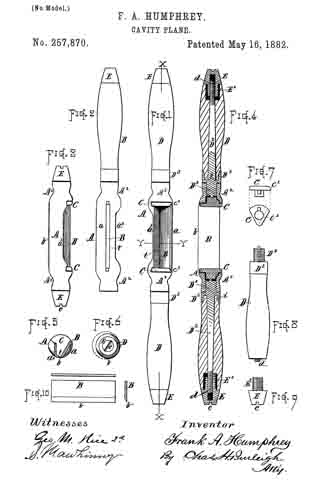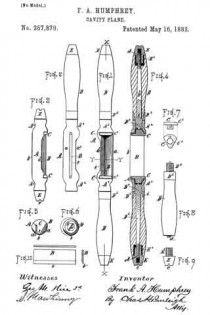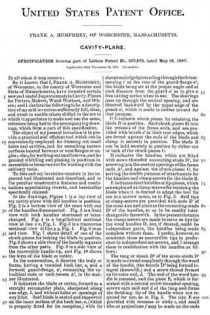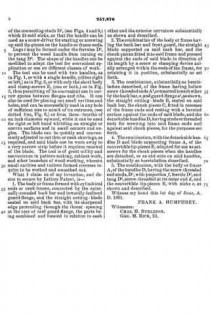
| PLEASE NOTE: The images presented on this page are of low resolution and, as a result, will not print out very well. If you wish to have higher resolution files then you may purchase them for only $2.95 per patent by using the "Buy Now" button below. All purchases are via PayPal. These files have all been cleaned up and digitally enhanced and are therefore suitable for printing, publication or framing. Each zip package contains all the images below (some packages may contain more), and purchased files can be downloaded immediately. |
UNITED STATES PATENT OFFICE.
_________________
FRANK A. HUMPHREY, OF WORCESTER, MASSACHUSETTS.
CAVITY-PLANE.
_________________
SPECIFICATION forming part of Letters Patent No. 257,870, dated May 16, 1882.
Application filed November 28, 1881. (No model.)
_________________
To all whom it may concern:
Be it known that I, FRANK A. HUMPHREY, of Worcester, in the county of Worcester and State of Massachusetts, have invented certain new and useful Improvements in Cavity-Planes for Pattern-Makers, Wood-Workers, and Others; and I declare the following to be a description of my said invention sufficiently full, clear, and exact to enable others skilled in the art to which it appertains to make and use the same, reference being had to the accompanying drawings, which form a part of this specification.
The object of my present invention is to provide a practical and efficient tool which can be conveniently employed for dressing out small holes and cavities, and for smoothing narrow surfaces located between or near flanges or angles; also, for working out small curves, and for general whittling and planing in positions inaccessible or inconvenient for working with the ordinary tools.
To this end my invention consists in the improved tool illustrated and described, and in the peculiar constructive features and combinations appertaining thereto, and hereinafter specifically claimed.
In the drawings, Figure 1 is a top view of my cavity-plane with full handles in position. Fig. 2 is a bottom view of the same with one of the handles disconnected. Fig. 3 is a front view with both handles shortened or interchanged. Fig. 4 is a longitudinal sectional view at line x x, Fig. 1. Fig. 5 is a transverse sectional view at line y y, Fig. 1. Fig. 6 is an end view. Fig. 7 shows detail of one of the chuck-pieces for locking the blade in position. Fig. 8 shows a side view of the handle separate from the other parts. Fig. 9 is a side view of the convertible handle-tip, and Fig. 10 shows the form of the blade or cutter.
In the construction, A denotes the body or frame, having a rounded back bar, a, and a forward guard-flange, a’, connecting the cylindrical ends or neck-bosses A2, in the manner illustrated.
B indicates the blade or cutter, formed as a straight rectangular plate, sharpened along one edge, b, and without holes or openings of any kind. Said blade is seated and supported on the inner surface of the back bar, a, (which is properly fitted for its reception,) with its sharpened edge b protruding throngh the throat-opening t at the rear of the guard-flange a’, the blade being set at the proper angle and at such distance from the guard a’ as to give a free cutting action when in use. The shavings pass up through the central opening, and are directed backward by the upper edge of the guard a’, which is made to incline inward for that purpose.
C C indicate chuck-pieces for retaining the blade B in position. Said chuck-pieces fit into the recesses of the frame ends, and are provided with bevels c’ at their rear edges, which are forced against the ends of the blade and clamp it securely in position. The blade B can be held securely in position by either one or both of the chuck-pieces C.
D indicates the handles, which are fitted with screw-threaded connecting-studs D’, for screwing into the central openings of the frame ends A2, and against the chuck-pieces C, for serving the double purpose of attachments for the handles and clamp-screws for the blade B.
E indicates short handles or tip-pieces, which are employed as clamp-screws for retaining the blade when it is desired to adapt the tool for use in a narrow space, as in Fig. 3. Said tips or clamp-screws are provided with ends E’ of the same size and pitch as the connecting-studs D’ of the handles, so as to be readily interchangeable therewith. In the present instance the clamp-screws are made to serve as tips for the wood handles D, but, if desired, could be independent parts, the handles being made complete without them. I prefer, however, to construct them as convertible tips in preference to independent set-screws, and I arrange them in combination with the handles as follows:
The tang or shank D2 of the screw-studs D’ is made to extend completely through the wood of the handle, (the ferrule D3 being formed integral therewith, ) and a screw-thread formed on its outer end, d. The end of the wood handle is recessed, and the piece E, which is furnished with a central screw-threaded opening, screws onto said end d of the tang and forms the finishing-tip of the handle when not required for use, as in Fig. 3. The tips E are provided with recesses or nicks e, and small ribs or projections f may be made on the ends of the connecting-studs D’, (see Figs. 4 and 8,) which fit said nicks, so that the handle can be used as a screw-driver for starting or screwing up said tip-pieces on the handle or frame ends.
Lugs i maybe formed under the fcrrnles D3, to prevent the wood handle from turning on the tang D2. The shape of the handles can be modified to adapt the tool for convenient application or use on different classes of work.
The tool can be used with two handles, as in Fig. 1, or with a single handle, (either right or left,) as in Fig. 2, or with only the short body and clamp-screws E, (one or both,) as in Fig.
3, thus permitting of its convenient use in narrow spaces between flanges and ribs. It can also be used for planing out small cavities and holes, and can be successfully used in any hole of sufficient size to admit of its entrance, (see dotted line, Fig. 6,) or from three-fourths of an inch diameter upward, while it can be used for right or left hand whittling on straight or convex surfaces and in small corners and angles. The blade can be quickly and conveniently adjusted to cut thin or rank shavings, as required, and said blade can be worn away to a very narrow strip before it requires renewal of the blade. The tool is of great utility and convenience in pattern-making, cabinet-work, and other branches of wood-working, wherein small cavities and various formed recesses require to be worked and smoothed out.
What I claim as of my invention, and desire to secure by Letters Patent, is —
1. The body or frame formed with cylindrical ends or neck-bosses, connected by the externally-rounded back bar and inwardly-inclined guard-flange, and the straight cutting-blade seated on said back bar, with its sharpened edge protruding through the throat-opening at the rear of said guard-flange, the parts being combined and located in relation to each other and the exterior curvature substantially as shown and described.
2. The combination of the body or frame having the back bar and front guard, the straight blade supported on said back bar, and the chuck-pieces fitted into said frame and pressed against the ends of said blade in direction of its length by a screw or clamping device axially arranged within the ends of the frame, for retaining it in position, substantially as set forth.
3. The combination, substantially as hereinbefore described, of the frame having hollow screw-threaded ends A2, connected to each other by the backbar, a,and guard-flange a’, as shown, the straight cutting- blade B, seated on said back bar, the chuck-pieces C, fitted in recesses of the frame ends and resting with a beveled surface against the ends of said blade, and the detachable handles D, having studs or threaded ends for screwing into said frame ends and against said chuck-pieces, for the purposes set forth.
4. The combination with the detachable handles D and blade supporting frame A, of the convertible tip-pieces E, adapted for use as set-screws for the chuck-pieces when the handles are detached, or as end nuts on said handles, substantially as hereinbefore described.
5. The combination, with the body or frame A, of the handles D, having the screw-threaded end studs, D’, with projection f, ferrule D3, and tang D2, screw-threaded at its outer end d, and the convertible tip-pieces E, with nicks e, as shown and described.
Witness my hand this lst day of June, A. D. 1881.
FRANK A. HUMPHREY.
Witnesses:
CHAS. H. BURLEIGH,
GEO. M. RICE, 2d.



